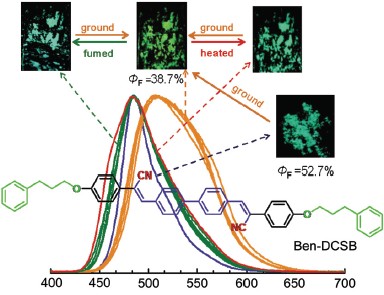| [1] Kitai, A. Luminescent Materials and Applications, John Wiley & Sons, Chichester, England, 2008. [2] Fukazawa, A.; Yamaguchi, S. Chem-Asian J. 2009, 4, 1386. [3] Entwistle, C. D.; Marder, T. B. Angew. Chem., Int. Ed. 2002, 41, 2927. [4] Hudson, Z. M.; Wang, S. Acc. Chem. Res. 2009, 42, 1584. [5] Toal, S. J.; Jones, K. A.; Magde, D.; Trogler, W. C. J. Am. Chem. Soc. 2005, 127, 11661. [6] Kishimura, A.; Yamashita, T.; Yamaguchi, K.; Aida, T. Nat. Mater. 2005, 4, 546. [7] Ning, Z.; Chen, Z.; Zhang, Q.; Yan, Y.; Qian, S.; Cao, Y.; Tian, H. Adv. Funct. Mater. 2007, 17, 3799. [8] Sagara, Y.; Kato, T. Nat. Chem. 2009, 1, 605. [9] Chi, Z. G.; Zhang, X. Q.; Xu, B. J.; Zhou, X.; Ma, C. P.; Zhang, Y.; Liu, S. W.; Xu, J. R. Chem. Soc. Rev. 2012, 41, 3878. [10] Kunzelman, J.; Kinami, M.; Crenshaw, B. R.; Protasiewicz, J. D.; Weder, C. Adv. Mater. 2008, 20, 119. [11]Yoon, S. J.; Chung, J. W.; Gierschner, J.; Kim, K. S.; Choi, M. G.; Kim, D.; Park, S. Y. J. Am. Chem. Soc. 2010, 132(39), 13675. [12] Ooyama, Y.; Kagawa, Y.; Fukuoka, H.; Ito, G.; Harima, Y. Eur. J. Org. Chem. 2009, 31, 5321. [13] Zhang, X. Q.; Chi, Z. G.; Zhang, J. Y.; Li, H. Y.; Xu, B. J.; Li, X. F.; Liu, S. W.; Zhang, Y.; Xu, J. R. J. Phys. Chem. B 2011, 115, 7606. [14] Zhang, X. Q.; Chi, Z. G.; Xu, B. J.; Chen, C. J.; Zhou, X.; Zhang, Y.; Liu, S. W.; Xu, J. R. J. Mater. Chem. 2012, 22, 18505. [15] Zhang, Z. L.; Yao, D. D.; Zhou, T. L.; Zhang, H. Y.; Wang, Y. Chem. Commun. 2011, 47, 7782. [16] Luo, X. L.; Li, J. L.; Li, C. H.; Heng, L. P.; Dong, Y. Q.; Liu, Z. P.; Bo, Z. S.; Tang, B. Z. Adv. Mater. 2011, 23, 3261. [17] Sase, M.; Yamaguchi, S.; Sagara, Y.; Yoshikawa, I.; Mutai, T.; Araki, K. J. Mater. Chem. 2011, 21, 8347. [18] Zhang, G. Q.; Lu, J. W.; Sabat, M.; Fraser, C. L. J. Am. Chem. Soc. 2010, 132(7), 2160. [19] Teng, M. J.; Jia, X. R.; Yang, S.; Chen, X. F.; Wei, Y. Adv. Mater. 2012, 9, 1255. [20] Luo, J.; Li, L. Y.; Song, Y.; Pei, J. Chem. Eur. J. 2011, 17, 10515. [21] Wang, C. G.; Chen, S. Y.; Wang, K.; Zhao, S. S.; Zhang, J. Y.; Wang, Y. J. Phys. Chem. C 2012, 116(33), 17796. [22] Dou, C.; Chen, D.; Iqbal, J.; Yuan, Y.; Zhang, H.; Wang, Y. Langmuir 2011, 27, 6323. [23] Zhang, Y. J.; Sun, J. W.; Bian, G. F.; Chen, Y. Y.; Ouyang, M.; Hu, B.; Zhang, C. Photochem. Photobiol. Sci. 2012, 11, 1414. [24] Ooyama, Y.; Ito, G.; Fukuoka, H.; Nagano, T.; Kagawa, Y.; Imae, I.; Komaguchi, K.; Harima, Y. Tetrahedron 2010, 66, 7268. [25] Ooyama, Y.; Harima, Y. J. Mater. Chem. 2011, 21, 8372. [26] Chen, J. W.; Law, C. C. W.; Lam, J. W. Y.; Dong, Y. P.; Lo, S. M. F.; Williams, I. D.; Zhu, D. B.; Tang, B. Z. Chem. Mater. 2003, 15, 1535. [27] Sagara, Y.; Mutai, T.; Yoshikawa, I.; Araki, K. J. Am. Chem. Soc. 2007, 129, 1520. Ouyang, M.; Yu, C. H.; Zhang, Y. J.; Hu, B.; Lü, X. J.; Sun, J. W.; Zhang, C. Acta Phys.-Chim. Sin. 2012, 28(12), 2944. (欧阳密, 俞春辉, 张玉建, 胡彬, 吕晓静, 孙璟玮, 张诚, 物理化学学报, 2012, 28(12), 2944.) |
